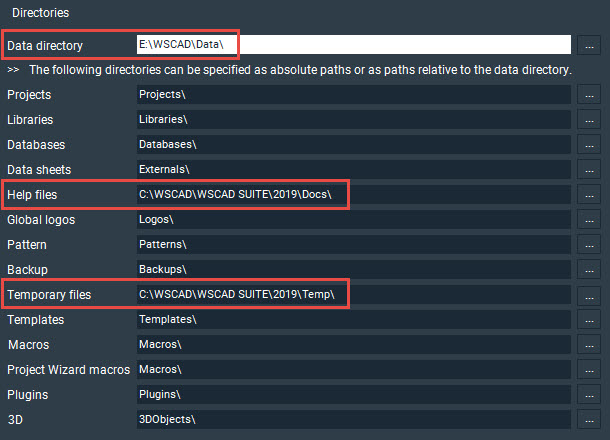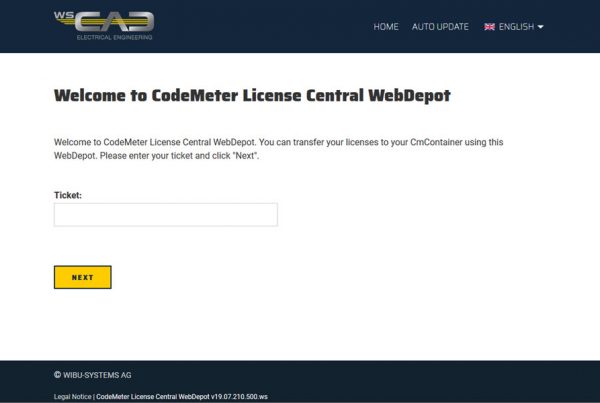
This blog is about installing the WSCAD software within network environments. It provides an overview of the possible scenarios and shows the general procedure.
The detailed installation of the WSCAD software locally on a PC or as a network version is described in the “Installation and Licensing” Guide (“Install Guide” for short). This Guide can be found as a PDF in the WSCAD installation directory in the “Docs” subfolder.
Please make sure that the WSCAD installation and data directories have sufficient executive access rights. For integrating the WSCAD software in complex network environments, please contact WSCAD Global Business Services (GBS, gbs@wscad.com).
Note: If you just want to operate the hardware dongle on a network server (e.g., license server), you do not need a network installation. In that case, you will need to first install the CodeMeter Control Center on the server and release the network license for the client PCs in the network from there (see “CodeMeter settings during server operation | Activate server PC with CodeMeter container” in the Installation Guide). In addition, the connection to the server must be set up on each client PC via the CodeMeter Control Center (see “CodeMeter settings during server operation | Entering the server PC on the client PC” in the Installation Guide).
Overview
This blog covers the following topics:
Network Scenarios
The WSCAD SUITE can be installed in the following network scenarios:
- Scenario 1a: WSCAD software local and data on server, settings on server
The WSCAD software is installed as a local installation on each client PC. All settings and data are stored on the Windows server. - Scenario 1b: WSCAD software local and data on server, settings local
The WSCAD software is installed as a local installation on each client PC. The settings also remain local, but refer to data directories stored on a server. - Scenario 2: WSCAD software and data on server
The WSCAD software is installed as a network installation on the Windows server. Each client PC has a WSCAD client network installation. - Scenario 3: Remote desktop connection
The WSCAD software is installed as a local installation on a Windows server. The clients access the WSCAD software via Remote Desktop Connection.
The following WSCAD data can be stored on the Windows server and is thus accessible to all clients:
- Projects
All projects from the Project Explorer; stored in the “Projects” directory. - Libraries
All symbol libraries from the Symbol Explorer; stored in the “Libraries” directory. - Databases
For example, part database, lexicon, addresses; stored in the “Databases” directory. - Data sheets
Stored in the “Externals” directory. - Globale Logos
Logos for frames; stored in the “Logos” directory. - Pattern
Predefined sets of frames and forms for lists and plans; stored in the “Patterns” directory. - Backups
All project backups as well as the automatic data backup; stored in the “Backups” directory. - Templates
All templates from the Template Explorer (frames and forms as well as labels and legends); stored in the “Templates” directory. - Macros
All macros from the Macro Explorer; stored in the “Macros” directory. - Project Wizard Macros
All macros of the “Project Wizard” Add-On; stored in the “Macros/Project Wizard” directory. - Plugins
All additionally installed plugins; stored in the “Plugins” directory. - 3D data
All 3D data for the three-dimensional view of the control cabinet; stored in the “3DObjects” directory.
Changes to these directories can be made in the WSCAD software under Tools | Settings (options) | Directories. The subdirectories are changed relative to the data directory.
Advantages and Disadvantages of Different Network Scenarios
| Scenario 1a: WSCAD software locally, settings and data on server | Scenario 1b: WSCAD software and settings locally, data on server | Scenario 2: WSCAD software and data on server | Scenario 3: Remote Desktop Connection | |
| Speed at work | ++ | ++ | – | + |
| Multi-monitor mode | unlimited | unlimited | unlimited | depend on server operating system |
| PC/laptop can be used outside the network (when switching to local data) | yes | yes | no | no |
| Program settings consistent on all workstations | yes | no | yes | yes |
| User settings consistent for each user on all workstations | yes | no | yes | yes |
| WSCAD update: local (per PC) | yes | yes | no | no |
| WSCAD update: server (only 1x) | no | no | yes | yes |
Scenario 1: WSCAD software local and data on server, settings on server or local
In this scenario, the WSCAD software is installed locally on each client PC. The data is located on the Windows server. It is thus available to all users in the network and is maintained centrally. The settings are either also centrally located on the server or locally on each client.
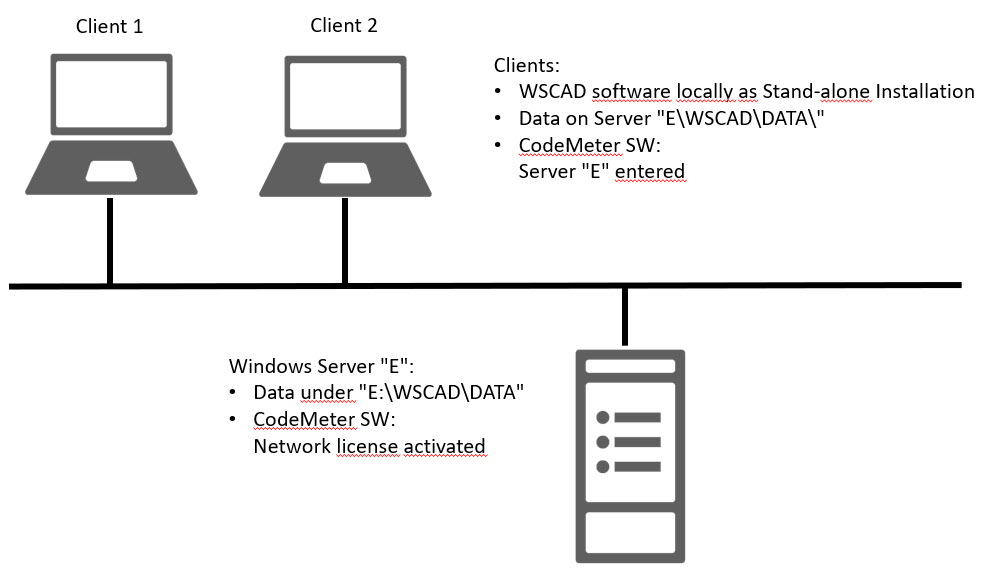
Procedure
- The WSCAD software is installed locally on each client PC as “a standalone installation” with the “default WSCAD installation settings” (see “Installation on standalone PC” in the Installation Guide”). For the installation, you need admin rights on the client PCs. The user needs Read, Write, Execute and Delete rights for the WSCAD installation directory on the client PC.
- The desired WSCAD data directories (see above) must be moved from the WSCAD installation directory to the Windows server. It is recommended not to change the names of the directories. The directories must be shared for the clients (Read, Write, Execute and Delete rights).
- On a client PC, the data directory must be changed in the WSCAD software (under Tools | Settings (options) | Directories) to the server directory to which the WSCAD data has been moved.
- The directories for the temporary files and the help files must remain local.

Scenario 1a: Move settings to the server
- Quit the WSCAD software.
- Move the
Settingsdirectory from the WSCAD installation directory to the server as in step 2. - Adapt the directory
CommonAppDatain the client PC fileC:\ProgramData\WSCAD\wscad.cfgin the section of the respective WSCAD version to the location of the settings directory on the server without specifying the settings directory itself.
Here is an example of a Settings directory of a WSCAD SUITE X PLUS (6.6.x.y) moved toP:\CAD-Daten\WSCAD\2020:

- On all further client PCs, now immediately after the installation (see step 1) the local settings directory has to be deleted and the file
C:\ProgramData\WSCAD\wscad.cfghas to be replaced by the file of the first client.
Scenario 1b: Keep settings local
- On the first client PC, export the WSCAD configuration settings including the just changed directory paths via Tools | Import/Export Settings | Export. All projects should be closed.
- These WSCAD configuration settings are to be imported at each client PC. Thus all data directories are changed to the server directory.
- Steps 5 and 6 must be repeated whenever changes are made to the program settings that are to be applied equally to all workstations.
Licensing
The CodeMeter drivers and the CodeMeter Control Center required for licensing are installed on the client PCs along with the installation. We recommend always keeping the CodeMeter software up to date, as the software is not automatically updated.
There are two variants for licensing:
- Local licensing
Each client PC contains a CodeMeter container with a local license. - Network licensing
The CodeMeter container with the network license is located on any PC that is always switched on in the network (e.g., Windows server or license server).
The network license must be released for the network via the CodeMeter Control Center on the server (see “CodeMeter settings during server operation | Activate server PC with CodeMeter container” in the Installation Guide).
On each client PC, the connection to the CodeMeter container must be set up via the CodeMeter Control Center. This is done by entering the IP address in the WebAdmin software of the CodeMeter Control Center in the server search list (see “CodeMeter settings during server operation | Entering the server PC on the client PC” in the Installation Guide).
In this scenario, you can also borrow licenses if you have purchased a UFC license
Scenario 2: WSCAD Software and Data on Server
In this scenario, the WSCAD software and the WSCAD data are stored on the Windows server. The WSCAD data is available to all users in the network and is maintained centrally. A WSCAD software update must only be performed on the Windows server.
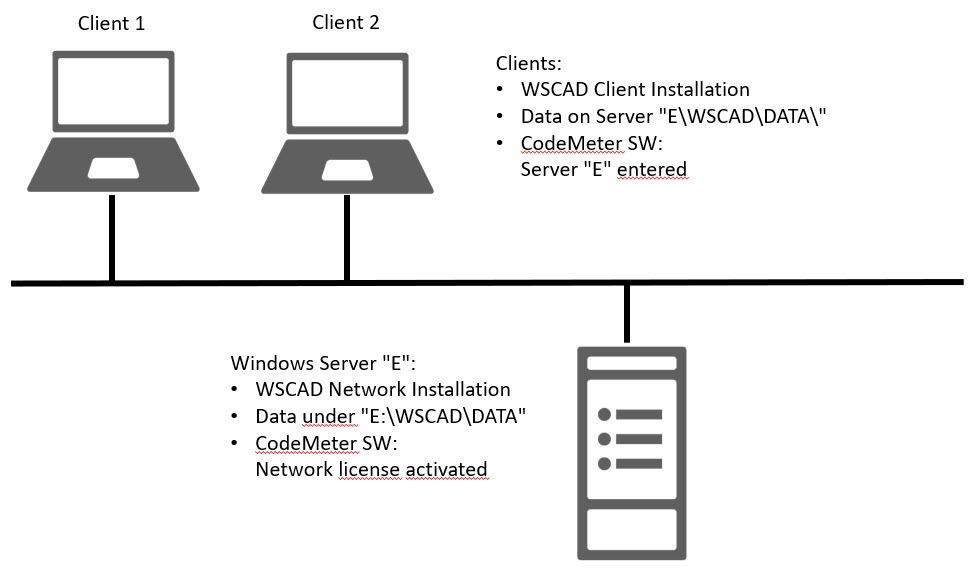
Procedure
- The WSCAD software is installed on the Windows server as a “WSCAD network installation” (see “Installation on server PC” in the Installation Guide). The installation requires admin rights. The WSCAD installation directory must be shared for the clients (Read, Write, and Delete rights).
- On each client, the WSCAD SUITE is installed as a “WSCAD client network installation” (see “Installation on client PC with admin rights” and “Installation on client PC without admin rights” in the Installation Guide). You can perform this installation with or without WSCAD admin rights. With WSCAD admin rights, users can change not only the user-specific and project-specific settings, but also the program-specific (= application-specific) settings. They can also perform a software update if they have Windows admin rights for the Windows server.
The following steps only need to be performed if the WSCAD data directory should not be located in the WSCAD installation directory but in another directory on the Windows server or on another network drive:
- The desired WSCAD data directories (see above) must be moved from the WSCAD installation directory to the WSCAD data directory. It is recommended not to change the names of the directories. The directory must be shared for the clients (Read, Write, Execute and Delete rights).
- On the Windows server, the data directory must be changed in the WSCAD software (under Tools | Settings (options) | Directories) to the server directory to which the WSCAD data has been moved.
- The directory for the temporary files must remain local.

Attention: A client PC on which the WSCAD installation was performed with admin rights can change the directory paths. These changes are stored on the server and then apply to all clients!
Licensing
The CodeMeter drivers and the CodeMeter Control Center required for licensing are installed on the Windows server along with the installation. The CodeMeter driver on the server and the client PCs must all have same status. We recommend always keeping the CodeMeter software up to date, as the software is not automatically updated.
There is only one option for licensing:
- Network licensing
The CodeMeter container with the network license is located on any PC that is always switched on in the network (e.g., Windows server or license server). When using a hardware dongle in a virtual environment, a dongle server is recommended.
The network license must be released for the network via the CodeMeter Control Center on the server (see “CodeMeter settings during server operation | Activate server PC with CodeMeter container” in the Installation Guide).
On each client PC, the connection to the CodeMeter container must be set up via the CodeMeter Control Center. This is done by entering the IP address in the WebAdmin software of the CodeMeter Control Center in the server search list (see “CodeMeter settings during server operation | Entering the server PC on the client PC” in the Installation Guide).
Scenario 3: Remote Desktop Connection
The WSCAD software can run as a local installation on a Windows server. In this case, the client PCs set up a remote desktop connection to the server. Via remote access software, the client has direct access to the WSCAD software on the server. The client works directly on the server from the PC.
The basis is a Windows server. This server can also be run as a virtual machine.
Usually Windows terminal servers or Citrix servers are used. Remote access must be allowed on the server. A special program for remote access to the server is started on the client.
Procedure
- The WSCAD software is installed on the Windows server as a “single user local installation”.
- Ensure that the Windows server is enabled and equipped for remote access.
- If not already present, the remote access software must be installed on the client PCs.
Licensing
The CodeMeter drivers and the CodeMeter Control Center required for licensing are installed on the Windows server along with the installation. We recommend always keeping the CodeMeter software up to date, as the software is not automatically updated.
There is only one option for licensing:
- Network licensing
The CodeMeter container with the network license is located on the Windows server. When using a hardware dongle in a virtual environment, a dongle server is recommended.
The network license must be released for the network via the CodeMeter Control Center on the Windows server (see “CodeMeter settings during server operation | Activate server PC with CodeMeter container” in the Installation Guide).
WSCAD Admin Rights
All users are automatically created with WSCAD admin rights, i.e., they can also change program-specific (application-specific) settings in addition to the user-specific and project-specific settings. Furthermore, they can perform a software update if they have Windows admin rights for the Windows server.
It is possible to revoke the WSCAD admin rights for all users already created. In addition, it is also possible to create all new users without WSCAD admin rights. If this is desired, please contact WSCAD Global Business Services (GBS, gbs@wscad.com).
Firewall
On the firewall, the following shares are required to use the services:
- UDP/TCP
- Ports 22350, 22351, 22352, 22353 (inbound and outbound)
So:
- CodeMeterFWExP22350-22353TCP (inbound and outbound)
- CodeMeterFWExP22350-22353UDP (inbound and outbound)
SQL Databases
For the WSCAD databases mentioned below, you can also use SQL databases (MS SQL recommended) on an SQL server instead of the Access databases used by default. To do this, you must set up a connection to the SQL database in the WSCAD settings and import the contents of the Access database into the SQL database. An SQL database on an SQL server performs better on the network than an Access database, especially with large amounts of data and many accesses. In addition, an SQL server can handle search queries faster and offers better options for data backups and interfaces to other databases. This facilitates a connection to an ERP system such as SAP.
For servers with limited performance, we recommend SQL Express (see https://docs.microsoft.com/de-de/sql/sql-server/editions-and-components-of-sql-server-2017?view=sql-server-2017#Cross-BoxScaleLimits).
These databases can be integrated as SQL databases and offer the following advantages:
- SQL part database
Faster loading and searching of part data. - SQL data point Management
Faster loading and searching of data points. - SQL lexicon
Faster translation runs.
The SQL databases are stored on the SQL server. The directories must be shared for the users (Read, Write, Execute and Delete rights).
The switch to SQL databases occurs in the WSCAD SUITE under Tools | Settings (options) | Master data.
Virtual Machines and Dongle Servers
For virtual machines, hardware copy protection and a dongle server (e.g. from SEH) are generally recommended.
Since the connection via the USB port is often problematic and error-prone in virtual environments, the hardware dongle should not be connected directly to a USB port of the server. Furthermore, in “fail over” constellations, where another server serves as a backup, this second server cannot access the hardware dongle on the USB port of the first server. Therefore it is recommended to use a dongle server.
One or more hardware dongles can be plugged into a dongle server. Within the virtual machine, the desired hardware dongle is mapped to a virtual USB port via the dongle server software. Thus, another virtual machine can use a different hardware dongle.
Even in a virtual environment, the network license must be enabled on the virtual server via the CodeMeter Control Center, and the virtual server must be entered at the client PCs.
WSCAD Software Updates
In scenario 1, the WSCAD SUITE is installed locally on all client PCs. In the case of a software update, the update would need to be download separately from the Internet on each client. Consequently, it is recommended to first download the update from the Internet to a network directory using one client and then install the update on the other clients from that directory.
In the WSCAD SUITE, you can specify the network directory under Tools | Settings (options) | Internet in the Update for distribution across multiple computers field and use the Download complete update button to save it in that directory. If the check box Search for update in directory only is selected, the client does not start the update via the Internet, but from this directory. If the check box Search automatically for update is also selected, the update will start automatically on starting the WSCAD SUITE.
Once this procedure has been set up on all clients, the system administrator can control which updates may be installed from the client PCs. The network directory must be shared for all client PCs.
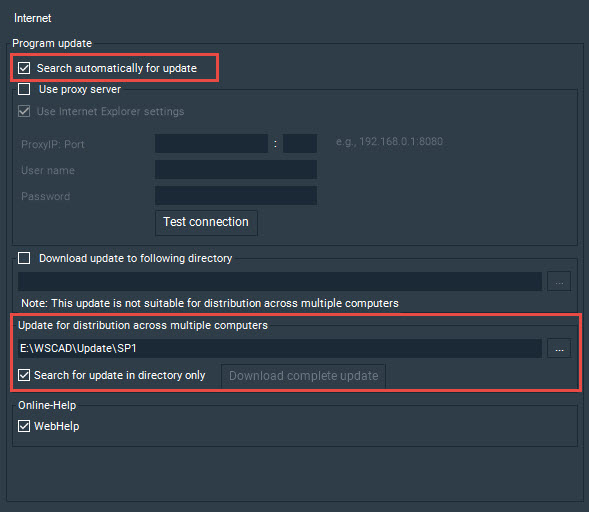
Notes
The following points must be observed for a network installation:
- WSCAD supports Windows Server 20016 and 2019.
- WSCAD supports Windows SQL Server 20017 and 2019.
- The data transfer rate in the network should be 1 Gbit/s.

Thomas Janowicz
Technical Writer,
Documentation Management
